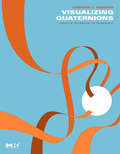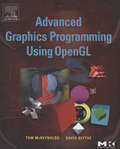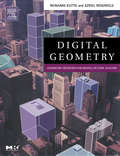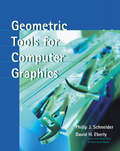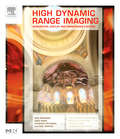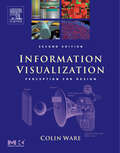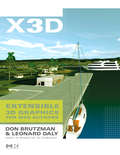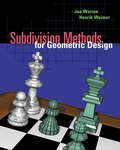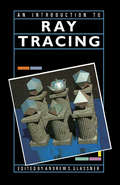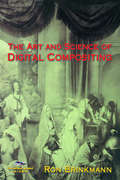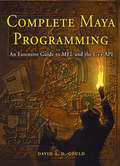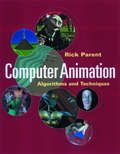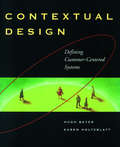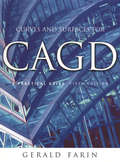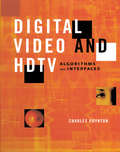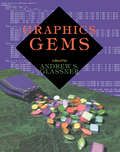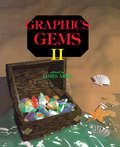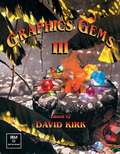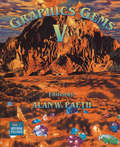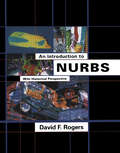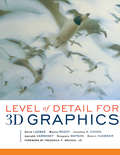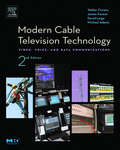- Table View
- List View
Visualizing Quaternions (The Morgan Kaufmann Series in Interactive 3D Technology)
by Andrew J. HansonIntroduced 160 years ago as an attempt to generalize complex numbers to higher dimensions, quaternions are now recognized as one of the most important concepts in modern computer graphics. They offer a powerful way to represent rotations and compared to rotation matrices they use less memory, compose faster, and are naturally suited for efficient interpolation of rotations. Despite this, many practitioners have avoided quaternions because of the mathematics used to understand them, hoping that some day a more intuitive description will be available.The wait is over. Andrew Hanson's new book is a fresh perspective on quaternions. The first part of the book focuses on visualizing quaternions to provide the intuition necessary to use them, and includes many illustrative examples to motivate why they are important—a beautiful introduction to those wanting to explore quaternions unencumbered by their mathematical aspects. The second part covers the all-important advanced applications, including quaternion curves, surfaces, and volumes. Finally, for those wanting the full story of the mathematics behind quaternions, there is a gentle introduction to their four-dimensional nature and to Clifford Algebras, the all-encompassing framework for vectors and quaternions.Richly illustrated introduction for the developer, scientist, engineer, or student in computer graphics, visualization, or entertainment computing.Covers both non-mathematical and mathematical approaches to quaternions.
Advanced Graphics Programming Using OpenGL (The Morgan Kaufmann Series in Computer Graphics)
by Tom McReynolds David BlytheToday truly useful and interactive graphics are available on affordable computers. While hardware progress has been impressive, widespread gains in software expertise have come more slowly. Information about advanced techniques—beyond those learned in introductory computer graphics texts—is not as easy to come by as inexpensive hardware. This book brings the graphics programmer beyond the basics and introduces them to advanced knowledge that is hard to obtain outside of an intensive CG work environment. The book is about graphics techniques—those that don’t require esoteric hardware or custom graphics libraries—that are written in a comprehensive style and do useful things. It covers graphics that are not covered well in your old graphics textbook. But it also goes further, teaching you how to apply those techniques in real world applications, filling real world needs.Emphasizes the algorithmic side of computer graphics, with a practical application focus, and provides usable techniques for real world problems. Serves as an introduction to the techniques that are hard to obtain outside of an intensive computer graphics work environment. Sophisticated and novel programming techniques are implemented in C using the OpenGL library, including coverage of color and lighting; texture mapping; blending and compositing; antialiasing; image processing; special effects; natural phenomena; artistic and non-photorealistic techniques, and many others.
Digital Geometry: Geometric Methods for Digital Picture Analysis (The Morgan Kaufmann Series in Computer Graphics)
by Reinhard Klette Azriel RosenfeldDigital geometry is about deriving geometric information from digital pictures. The field emerged from its mathematical roots some forty-years ago through work in computer-based imaging, and it is used today in many fields, such as digital image processing and analysis (with applications in medical imaging, pattern recognition, and robotics) and of course computer graphics. Digital Geometry is the first book to detail the concepts, algorithms, and practices of the discipline. This comphrehensive text and reference provides an introduction to the mathematical foundations of digital geometry, some of which date back to ancient times, and also discusses the key processes involved, such as geometric algorithms as well as operations on pictures.*A comprehensive text and reference written by pioneers in digital geometry, image processing and analysis, and computer vision*Provides a collection of state-of-the-art algorithms for a wide variety of geometrical picture analysis tasks, including extracting data from digital images and making geometric measurements on the data*Includes exercises, examples, and references to related or more advanced work
Geometric Tools for Computer Graphics (The Morgan Kaufmann Series in Computer Graphics)
by David H. Eberly Philip SchneiderDo you spend too much time creating the building blocks of your graphics applications or finding and correcting errors? Geometric Tools for Computer Graphics is an extensive, conveniently organized collection of proven solutions to fundamental problems that you'd rather not solve over and over again, including building primitives, distance calculation, approximation, containment, decomposition, intersection determination, separation, and more.If you have a mathematics degree, this book will save you time and trouble. If you don't, it will help you achieve things you may feel are out of your reach. Inside, each problem is clearly stated and diagrammed, and the fully detailed solutions are presented in easy-to-understand pseudocode. You also get the mathematics and geometry background needed to make optimal use of the solutions, as well as an abundance of reference material contained in a series of appendices.FeaturesFilled with robust, thoroughly tested solutions that will save you time and help you avoid costly errors.Covers problems relevant for both 2D and 3D graphics programming.Presents each problem and solution in stand-alone form allowing you the option of reading only those entries that matter to you.Provides the math and geometry background you need to understand the solutions and put them to work.Clearly diagrams each problem and presents solutions in easy-to-understand pseudocode.Resources associated with the book are available at the companion Web site www.mkp.com/gtcg.* Filled with robust, thoroughly tested solutions that will save you time and help you avoid costly errors.* Covers problems relevant for both 2D and 3D graphics programming.* Presents each problem and solution in stand-alone form allowing you the option of reading only those entries that matter to you.* Provides the math and geometry background you need to understand the solutions and put them to work.* Clearly diagrams each problem and presents solutions in easy-to-understand pseudocode.* Resources associated with the book are available at the companion Web site www.mkp.com/gtcg.
High Dynamic Range Imaging: Acquisition, Display, and Image-Based Lighting (The Morgan Kaufmann Series in Computer Graphics)
by Erik Reinhard Greg Ward Sumanta Pattanaik Paul DebevecHigh dynamic range imaging produces images with a much greater range of light and color than conventional imaging. The effect is stunning, as great as the difference between black-and-white and color television. High Dynamic Range Imaging is the first book to describe this exciting new field that is transforming the media and entertainment industries. Written by the foremost researchers in HDRI, it will explain and define this new technology for anyone who works with images, whether it is for computer graphics, film, video, photography, or lighting design.* Written by the leading researchers in HDRI* Covers all the areas of high dynamic range imaging including capture devices, display devices, file formats, dynamic range reduction, and image-based lighting* Includes a DVD with over 4 GB of HDR images as well as source code and binaries for numerous tone reproduction operators for Windows, Linux, and Mac OS X
Information Visualization: Perception for Design (Interactive Technologies)
by Colin WareInformation Visualization is the major revision of a classic work on information visualization. This book explores the art and science of why we see objects the way we do. Based on the science of perception and vision, the author presents the key principles at work for a wide range of applications - resulting in visualization of improved clarity, utility, and persuasiveness. This is the first work to use the science of perception to help serious designers and analysts optimize understanding and perception of their data visualizations. This unique and essential guide to human visual perception and related cognitive principles will enrich courses on information visualization and empower designers to see their way forward. Its updated review of empirical research and interface design examples will do much to accelerate innovation and adoption of information visualization. New to this edition are a new chapter on visual thinking, new sections on face perception and flow visualization, and a much-expanded chapter on color and color sequences. This book will appeal to interaction designers; graphic designers of all kinds (including web designers); financial analysts; research scientists and engineers; data miners; and managers faced with information-intensive challenges.*First work to use the science of perception to help serious designers and analysts optimize understanding and perception of their data visualizations.* Major revision of this classic work, with a new chapter on visual thinking, new sections on face perception and flow visualization, and a much expanded chapter on color and color sequences. *New to this edition is the full color treatment throughout, to better display over 400 illustrations.
Media and the American Child
by George Comstock Erica ScharrerMedia and the American Child summarizes the research on all forms of media on children, looking at how much time they spend with media everyday, television programming and its impact on children, how advertising has changed to appeal directly to children and the effects on children and the consumer behavior of parents, the relationship between media use and scholastic achievement, the influence of violence in media on anti-social behavior, and the role of media in influencing attitudes on body image, sex and work roles, fashion, & lifestyle. The average American child, aged 2-17, watches 25 hours of TV per week, plays 1 hr per day of video or computer games, and spends an additional 36 min per day on the internet. 19% of children watch more than 35 hrs per week of TV. This in the face of research that shows TV watching beyond 10 hours per week decreases scholastic performance. In 1991, George Comstock published Television and the American Child, which immediately became THE standard reference for the research community of the effects of television on children. Since then, interest in the topic has mushroomed, as the availability and access of media to children has become more widespread and occurs earlier in their lifetimes. No longer restricted to television, media impacts children through the internet, computer and video games, as well as television and the movies. There are videos designed for infants, claiming to improve cognitive development, television programs aimed for younger and younger children-even pre-literates, computer programs aimed for toddlers, and increasingly graphic, interactive violent computer games. Presents the most recent research on the media use of young people Investigates the content of children's media and addresses areas of great concern including violence, sexual behavior, and commercialization Discusses policy making in the area of children and the media Focuses on experiences unique to children and adolescents
X3D: Extensible 3D Graphics for Web Authors (The Morgan Kaufmann Series in Computer Graphics)
by Don Brutzman Leonard DalyIn the early days of the Web a need was recognized for a language to display 3D objects through a browser. An HTML-like language, VRML, was proposed in 1994 and became the standard for describing interactive 3D objects and worlds on the Web. 3D Web courses were started, several best-selling books were published, and VRML continues to be used today. However VRML, because it was based on HTML, is a stodgy language that is not easy to incorporate with other applications and has been difficult to add features to. Meanwhile, applications for interactive 3D graphics have been exploding in areas such as medicine, science, industry, and entertainment. There is a strong need for a set of modern Web-based technologies, applied within a standard extensible framework, to enable a new generation of modeling & simulation applications to emerge, develop, and interoperate. X3D is the next generation open standard for 3D on the web. It is the result of several years of development by the Web 3D Consortium's X3D Task Group. Instead of a large monolithic specification (like VRML), which requires full adoption for compliance, X3D is a component-based architecture that can support applications ranging from a simple non-interactive animation to the latest streaming or rendering applications. X3D replaces VRML, but also provides compatibility with existing VRML content and browsers. Don Brutzman organized the first symposium on VRML and is playing a similar role with X3D; he is a founding member of the consortium. Len Daly is a professional member of the consortium and both Len and Don have been involved with the development of the standard from the start.The first book on the new way to present interactive 3D content over the Web, written by two of the designers of the standardPlentiful illustrations and screen shots in the full color textCompanion website with extensive content, including the X3D specification, sample code and applications, content creation tools, and demos of compatible Web browsers
Subdivision Methods for Geometric Design: A Constructive Approach (The Morgan Kaufmann Series in Computer Graphics)
by Joe Warren Henrik WeimerSubdivision Methods for Geometric Design provides computer graphics students and designers with a comprehensive guide to subdivision methods, including the background information required to grasp underlying concepts, techniques for manipulating subdivision algorithms to achieve specific effects, and a wide array of digital resources on a dynamic companion Web site. Subdivision Methods promises to be a groundbreaking book, important for both advanced students and working professionals in the field of computer graphics.The only book devoted exclusively to subdivision techniquesCovers practical topics including uniform Bezier and B-Spline curves, polyhedral meshes, Catmull-Clark subdivision for quad meshes and objects with sharp creases and pointed verticesA companion website provides example code and concept implementations of subdivision concepts in an interactive Mathematica environment
An Introduction to Ray Tracing (The Morgan Kaufmann Series in Computer Graphics)
by Andrew S. GlassnerThe creation of ever more realistic 3-D images is central to the development of computer graphics. The ray tracing technique has become one of the most popular and powerful means by which photo-realistic images can now be created. The simplicity, elegance and ease of implementation makes ray tracing an essential part of understanding and exploiting state-of-the-art computer graphics.An Introduction to Ray Tracing develops from fundamental principles to advanced applications, providing "how-to" procedures as well as a detailed understanding of the scientific foundations of ray tracing. It is also richly illustrated with four-color and black-and-white plates. This is a book which will be welcomed by all concerned with modern computer graphics, image processing, and computer-aided design.Provides practical "how-to" informationContains high quality color plates of images created using ray tracing techniquesProgresses from a basic understanding to the advanced science and application of ray tracing
The Art and Science of Digital Compositing (The Morgan Kaufmann Series in Computer Graphics)
by Ron BrinkmannComputer-generated visual effects are now used extensively in feature films, commercials, music videos, and multimedia. The backbone of this process, the final and most important step, is known as digital compositing. The Art and Science of Digital Compositing is a comprehensive reference that provides a complete overview of the technical and the artistic nature of this process. This book covers a wide range of topics from basic image creation, representation, and manipulation, to a look at the visual cues that are necessary to create a believable composite. Designed as both an introduction to the field as well as a valuable technical reference, this book should be of interest to both novices and professionals alike. Written by a working professional in the visual effects industry, the book provides over 250 different images and illustrations (including a 40-page color insert) as well as a complete glossary of compositing and visual-effects terminology. Also included are in-depth case studies from well-known films such as Speed, Independence Day, and Titanic.Balances fundamental "hard science" topics with the more qualitative/artistic challenges which face anyone involved in a digital composition projectProvides examples and illustrations from motion picture workCD-ROM contains additional composition examples, illustrations, and development softwareIncludes 32 pages of colour
Complete Maya Programming: An Extensive Guide to MEL and C++ API (The Morgan Kaufmann Series in Computer Graphics)
by David GouldLearning Maya, the world's leading 3D animation and effects package, is a challenge, especially for those who want to master Maya's versatile programming features in addition to its built-in tools. Finally, here is a practical, step-by-step guide that shows how to use Maya to its fullest potential, beginning with the basics. Readers of Complete Maya Programming will first gain a thorough understanding of Maya's inner workings, and then learn how to customize and extend Maya with scripts and plugins that take control and productivity to new levels.Users new to programming can apply Maya's easy scripting language MEL (Maya Embedded Language), while more advanced users can work with the C++ API (Application Progamming Interface). Both a fundamental tutorial for Maya beginners and a solid reference for experienced developers, Complete Maya Programming is every user's guide to Maya mastery.* Provides a multitude of real-world examples illustrating applications of Maya programming.* Demonstrates how to use MEL to control Maya, customize its interface, automate procedures, and more* Details how to use the C++ API to modify Maya functionality and develop tools and features to meet any need* Explains when to use MEL, when to use the C++ API, and how to use them together* Ideal for technical directors, developers, or anyone wishing to to master Maya* Provides a storehouse of MEL scripts and C++ source code, glossary, and list of resources, available at www.davidgould.com
Computer Animation: Algorithms and Techniques (The Morgan Kaufmann Series in Computer Graphics)
by Rick ParentWhether you're a programmer developing new animation functionality or an animator trying to get the most out of your current animation software, Computer Animation: Algorithms and Techniques will help work more efficiently and achieve better results. For programmers, this book provides a solid theoretical orientation and extensive practical instruction-information you can put to work in any development or customization project. For animators, it provides crystal-clear guidance on determining which of your concepts can be realized using commercially available products, which demand custom programming, and what development strategies are likely to bring you the greatest success.* Expert instruction from a pace-setting computer graphics researcher.* Provides in-depth coverage of established and emerging animation algorithms.* For readers who lack a strong scientific background, introduces the necessary concepts from mathematics and physics.* Illustrates advanced programming techniques with highly detailed working examples.* Via the companion Web site, provides lecture notes from the author's course for professors, example animations based on the programs covered in the book, Java applets, and links to relevant Web sites.* Special contributions from Dave S. Ebert on Natural Phenomena in Chapter 5* Special contributions from Scott King, Meg Geroch, Doug Roble, and Matt Lewis on Articulated Figures in Chapter 6.
Contextual Design: Defining Customer-Centered Systems (Interactive Technologies)
by Karen Holtzblatt Hugh BeyerThis book introduces a customer-centered approach to business by showing how data gathered from people while they work can drive the definition of a product or process while supporting the needs of teams and their organizations. This is a practical, hands-on guide for anyone trying to design systems that reflect the way customers want to do their work. The authors developed Contextual Design, the method discussed here, through their work with teams struggling to design products and internal systems. In this book, you'll find the underlying principles of the method and how to apply them to different problems, constraints, and organizational situations.Contextual Design enables you to+ gather detailed data about how people work and use systems + develop a coherent picture of a whole customer population + generate systems designs from a knowledge of customer work+ diagram a set of existing systems, showing their relationships, inconsistencies, redundancies, and omissions
Curves and Surfaces for CAGD: A Practical Guide (The Morgan Kaufmann Series in Computer Graphics)
by Gerald FarinThis fifth edition has been fully updated to cover the many advances made in CAGD and curve and surface theory since 1997, when the fourth edition appeared. Material has been restructured into theory and applications chapters. The theory material has been streamlined using the blossoming approach; the applications material includes least squares techniques in addition to the traditional interpolation methods. In all other respects, it is, thankfully, the same. This means you get the informal, friendly style and unique approach that has made Curves and Surfaces for CAGD: A Practical Guide a true classic. The book's unified treatment of all significant methods of curve and surface design is heavily focused on the movement from theory to application. The author provides complete C implementations of many of the theories he discusses, ranging from the traditional to the leading-edge. You'll gain a deep, practical understanding of their advantages, disadvantages, and interrelationships, and in the process you'll see why this book has emerged as a proven resource for thousands of other professionals and academics.Provides authoritative and accessible information for those working with or developing computer-aided geometric design applicationsCovers all significant CAGD curve and surface design techniques-from the traditional to the experimentalIncludes a new chapter on recursive subdivision and triangular meshesPresents topical programming exercises useful to professionals and students alike
Digital Video and HD: Algorithms and Interfaces (The Morgan Kaufmann Series in Computer Graphics)
by Charles PoyntonRapidly evolving computer and communications technologies have achieved data transmission rates and data storage capacities high enough for digital video. But video involves much more than just pushing bits! Achieving the best possible image quality, accurate color, and smooth motion requires understanding many aspects of image acquisition, coding, processing, and display that are outside the usual realm of computer graphics. At the same time, video system designers are facing new demands to interface with film and computer system that require techniques outside conventional video engineering.Charles Poynton's 1996 book A Technical Introduction to Digital Video became an industry favorite for its succinct, accurate, and accessible treatment of standard definition television (SDTV). In Digital Video and HDTV, Poynton augments that book with coverage of high definition television (HDTV) and compression systems.For more information on HDTV Retail markets, go to: http://www.insightmedia.info/newsletters.php#hdtvWith the help of hundreds of high quality technical illustrations, this book presents the following topics:* Basic concepts of digitization, sampling, quantization, gamma, and filtering* Principles of color science as applied to image capture and display* Scanning and coding of SDTV and HDTV* Video color coding: luma, chroma (4:2:2 component video, 4fSC composite video)* Analog NTSC and PAL* Studio systems and interfaces* Compression technology, including M-JPEG and MPEG-2* Broadcast standards and consumer video equipment
Graphics Gems (Graphics Gems - IBM)
by Andrew S. Glassner"The GRAPHICS GEMS Series" was started in 1990 by Andrew Glassner. The vision and purpose of the Series was - and still is - to provide tips, techniques, and algorithms for graphics programmers. All of the gems are written by programmers who work in the field and are motivated by a common desire to share interesting ideas and tools with their colleagues. Each volume provides a new set of innovative solutions to a variety of programming problems.
Graphics Gems II (Graphics Gems - IBM)
by James ArvoGraphics Gems II is a collection of articles shared by a diverse group of people that reflect ideas and approaches in graphics programming which can benefit other computer graphics programmers.This volume presents techniques for doing well-known graphics operations faster or easier. The book contains chapters devoted to topics on two-dimensional and three-dimensional geometry and algorithms, image processing, frame buffer techniques, and ray tracing techniques. The radiosity approach, matrix techniques, and numerical and programming techniques are likewise discussed.Graphics artists and computer programmers will find the book invaluable.
Graphics Gems III: Ibm Version (Graphics Gems - IBM)
by David KirkThis sequel to Graphics Gems (Academic Press, 1990), and Graphics Gems II (Academic Press, 1991) is a practical collection of computer graphics programming tools and techniques. Graphics Gems III contains a larger percentage of gems related to modeling and rendering, particularly lighting and shading. This new edition also covers image processing, numerical and programming techniques, modeling and transformations, 2D and 3D geometry and algorithms,ray tracing and radiosity, rendering, and more clever new tools and tricks for graphics programming. Volume III also includes a disk containing source codes for either the IBM or Mac versions featuring all code from Volumes I, II, and III. Author David Kirk lends his expertise to the Graphics Gems series in Volume III with his far-reaching knowledge of modeling and rendering, specifically focusing on the areas of lighting and shading. Volume III includes a disk containing source codes for both the IBM and Mac versions featuring all code from volumes I, II, and III. Graphics Gems I, II, and III are sourcebooks of ideas for graphics programmers. They also serve as toolboxes full of useful tricks and techniques for novice programmers and graphics experts alike. Each volume reflects the personality and particular interests of its respective editor.Includes a disk containing source codes for both the IBM and Mac versions featuring code from volumes I, II, and IIIFeatures all new graphics gemsExplains techniques for making computer graphics implementations more efficientEmphasizes physically based modeling, rendering, radiosity, and ray tracingPresents techniques for making computer graphics implementations more efficient
Graphics Gems IV (The Morgan Kaufmann Series in Computer Graphics)
by Paul HeckbertGraphics Gems IV is the newest volume in the Graphics Gems series. All of the books in the series contain practical solutions for graphics problems using the latest techniques in the field. The books in this series have become essential, time saving toolsfor many programmers. Volume IV is a collection of carefully crafted gems which are all new and innovative. All of the gems are immediately accessible and useful in formulating clean, fast, and elegant programs. The C programming language has been used for most of the program listings, although several of the gems have C++ implementations. *IBM version Includes one 3 1/2" high-density disk. System Requirements: 286 or higher IBM PC compatible, DOS 4.0 or higher
Graphics Gems V (The Morgan Kaufmann Series in Computer Graphics)
by Alan W. PaethGraphics Gems V is the newest volume in The Graphics Gems Series. It is intended to provide the graphics community with a set of practical tools for implementing new ideas and techniques, and to offer working solutions to real programming problems. These tools are written by a wide variety of graphics programmers from industry, academia, and research. The books in the series have become essential, time-saving tools for many programmers.Latest collection of graphics tips in The Graphics Gems Series written by the leading programmers in the fieldContains over 50 new gems displaying some of the most recent and innovative techniques in graphics programmingIncludes gems covering ellipses, splines, Bezier curves, and ray tracing
An Introduction to NURBS: With Historical Perspective (The Morgan Kaufmann Series in Computer Graphics)
by David F. RogersThe latest from a computer graphics pioneer, An Introduction to NURBS is the ideal resource for anyone seeking a theoretical and practical understanding of these very important curves and surfaces. Beginning with Bézier curves, the book develops a lucid explanation of NURBS curves, then does the same for surfaces, consistently stressing important shape design properties and the capabilities of each curve and surface type. Throughout, it relies heavily on illustrations and fully worked examples that will help you grasp key NURBS concepts and deftly apply them in your work. Supplementing the lucid, point-by-point instructions are illuminating accounts of the history of NURBS, written by some of its most prominent figures. Whether you write your own code or simply want deeper insight into how your computer graphics application works, An Introduction to NURBS will enhance and extend your knowledge to a degree unmatched by any other resource.Presents vital information with applications in many different areas: CAD, scientific visualization, animation, computer games, and more.Facilitates accessiblity to anyone with a knowledge of first-year undergraduate mathematics.Details specific NURBS-based techniques, including making cusps with B-spline curves and conic sections with rational B-spline curves.Presents all important algorithms in easy-to-read pseudocode-useful for both implementing them and understanding how they work.Includes complete references to additional NURBS resources.
Jim Blinn's Corner: Notation, Notation, Notation (The Morgan Kaufmann Series in Computer Graphics)
by Jim BlinnThe third entry in the Jim Blinn's Corner series, this is, like the others, a handy compilation of selected installments of his influential column. But here, for the first time, you get the "Director's Cut" of the articles: revised, expanded, and enhanced versions of the originals. What's changed? Improved mathematical notation, more diagrams, new solutions. What remains the same? All the things you've come to rely on: straight answers, irreverent style, and innovative thinking. This is Jim Blinn at his best - now even better.Features 21 expanded and updated installments of "Jim Blinn's Corner," dating from 1995 to 2001, and never before published in book formIncludes "deleted scenes"—tangential explorations that didn't make it into the original columnsDetails how Blinn represented planets in his famous JPL flyby animationsExplores a wide variety of other topics, from the concrete to the theoretical: assembly language optimization for parallel processors, exotic usage of C++ template instantiation, algebraic geometry, a graphical notation for tensor contraction, and his hopes for a future world
Level of Detail for 3D Graphics (The Morgan Kaufmann Series in Computer Graphics)
by David Luebke Martin Reddy Jonathan D. Cohen Amitabh Varshney Benjamin Watson Robert HuebnerLevel of detail (LOD) techniques are increasingly used by professional real-time developers to strike the balance between breathtaking virtual worlds and smooth, flowing animation. Level of Detail for 3D Graphics brings together, for the first time, the mechanisms, principles, practices, and theory needed by every graphics developer seeking to apply LOD methods.Continuing advances in level of detail management have brought this powerful technology to the forefront of 3D graphics optimization research. This book, written by the very researchers and developers who have built LOD technology, is both a state-of-the-art chronicle of LOD advances and a practical sourcebook, which will enable graphics developers from all disciplines to apply these formidable techniques to their own work.* Is a complete, practical resource for programmers wishing to incorporate LOD technology into their own systems.* Is an important reference for professionals in game development, computer animation, information visualization, real-time graphics and simulation, data capture and preview, CAD display, and virtual worlds.* Is accessible to anyone familiar with the essentials of computer science and interactive computer graphics.* Covers the full range of LOD methods from mesh simplification to error metrics, as well as advanced issues of human perception, temporal detail, and visual fidelity measurement.* Includes an accompanying Web site rich in supplementary material including source code, tools, 3D models, public domain software, documentation, LOD updates, and more. Visit http://LODBook.com.
Modern Cable Television Technology (ISSN)
by David Large James FarmerFully updated, revised, and expanded, this second edition of Modern Cable Television Technology addresses the significant changes undergone by cable since 1999--including, most notably, its continued transformation from a system for delivery of television to a scalable-bandwidth platform for a broad range of communication services. It provides in-depth coverage of high speed data transmission, home networking, IP-based voice, optical dense wavelength division multiplexing, new video compression techniques, integrated voice/video/data transport, and much more. Intended as a day-to-day reference for cable engineers, this book illuminates all the technologies involved in building and maintaining a cable system. But it's also a great study guide for candidates for SCTE certification, and its careful explanations will benefit any technician whose work involves connecting to a cable system or building products that consume cable services.Written by four of the most highly-esteemed cable engineers in the industry with a wealth of experience in cable, consumer electronics, and telecommunicationsAll new material on digital technologies, new practices for delivering high speed data, home networking, IP-based voice technology, optical dense wavelength division multiplexing (DWDM), new video compression techniques, and integrated voice/video/data transportCovers the latest on emerging digital standards for voice, data, video, and multimediaPresents distribution systems, from drops through fiber optics, an covers everything from basic principles to network architectures
